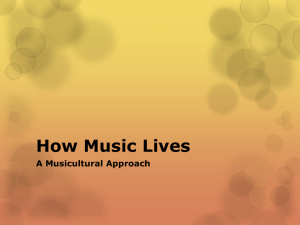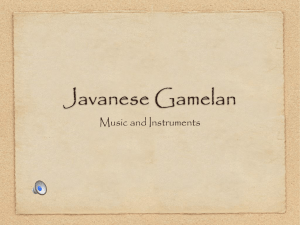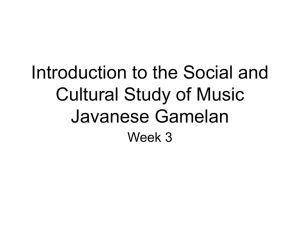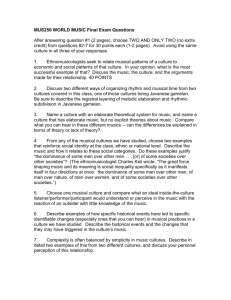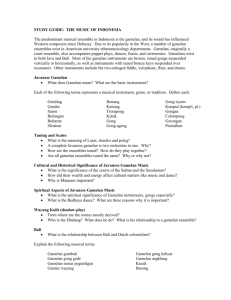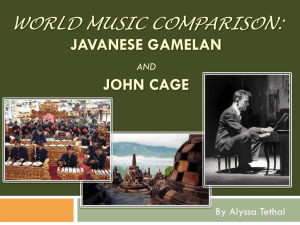Part III: Island Southeast Asia
advertisement
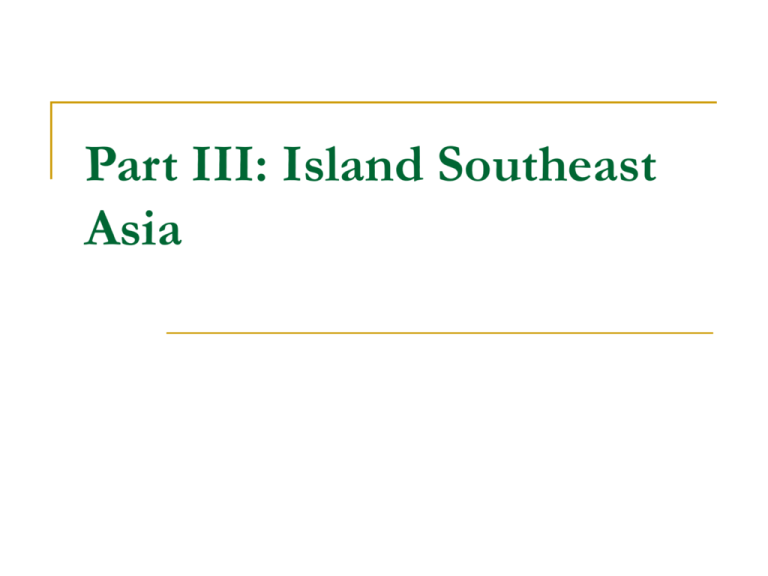
Part III: Island Southeast Asia Island Southeast Asia: an Introduction The archipelago chapters: Indonesia, the Philippines, Borneo nations: Malaysia, Brunei, Indonesia, the Philippines physical and cultural geography Musical instruments depend on available materials Bronze Wood bamboo Musical styles bear similarities across the region layers of parts in stratification interlocking patterns composite rhythms and melodies vocal music crosses many genres Questions for Discussion Why are the chapters divided by geography, not by nation? What do natural resources have to do with music production? Can one talk about the separate islands as being part of a unified culture group? Indonesia: Sumatra Introduction to island diversity independence from the Dutch in 1945 at least 13,000 islands, including Sumatra, Java, Bali, and others prevalence of gong-chime ensembles Sumatran cultural history bronze kettledrums Buddhist and Hindu temples and kingdoms entry of Islam in the 13th century European conquest in the 16th century Sumatran regional music: special region of Aceh Muslim devotional arts rapa’i frame drum daboih: religious acts of chanting and selfmortification seudati: choral singing with body percussion Sumatran regional music: North Sumatra province animist stratum (songs, xylophones, tilempong) Muslim stratum (devotional songs, rebana frame drum, gambus lute) Portuguese-Malay stratum (secular songs and Western instruments) Sumatran regional music: West Sumatra province Minangkabau highlands (talempong and saluang; randai theater) coastal areas (localized talempong, 3stringed fiddles, long tales) Mentawai islands (slit drums and other percussion, ritual songs) Sumatran regional music: Riau province animist beliefs, ritual songs, sempelong flute bronze bells, gambang xylophone ensembles, celempong ensembles storytelling, improvised poetry, long songs erotic dancing Sumatran regional music: Jambi province pre-Islamic genres (healing ceremonies, self defense, courting music) post-Portuguese music (orkes Melayu, kelintang gong music) nomadic people play portable instruments Sumatran regional music: Bengkulu province famous for megalithic monuments and large national park many ceremonial dances around a wooden pole vocal genre dendang Sumatran regional music: South Sumatra province pre-Hindu-Buddhist traditions still exist (songs, flutes) bronze gong-and-drum ensembles represent Hindu-Buddhist stratum orkes Melayu and orkes gambus represent the Muslim stratum Sumatran regional music: Lampung province huge impact of Javanese in-migration music for Jew’s harp, flute, and songs belong to ancient Abung culture pre-Muslim bronze ensembles Questions for Discussion What do most of these regions have in common? How do the different layers of influence interact with each other? What aspects of Sumatran music are animist? Indonesia: Java Javanese introduction dense population contrasts with expansive rice fields and volcanoes distinctions between Central and East Java, Cirebon, and Sunda Central and East Javanese history Hindu-Javanese period: Majapahit Islamic period: Mataram European period: Dutch East-India Company Central Javanese cultural geography court traditions of Surakarta and Yogyakarta in Central Java distinctions between alus (refined, subtle) and gagah (strong, robust) East Java as a culturally distinct area Central Javanese gamelan instruments gongs metallophones stringed instruments percussion singers Central Javanese non-gamelan instruments gamelan klenèngan (soft-playing instruments) calung (bamboo xylophone ensemble) gandrung (violins, drums, gong, triangle) angklung (multioctave bambook xylophone, metallphones, flute/oboe) hobby-horse trance dance, small percussion ensembles The relationship between Central Javanese music, dance, and theater singer-dancer traditions acting dances puppet theater (wayang kulit) Central Javanese tuning systems, scales, and modes laras (scale, tuning) sléndro and pélog pathet (tonal hierarchy, range, intervallic structure) Central Javanese repertoires and formal structures gendhing (gamelan pieces with cyclic structures) balungan (skeletal melody and basis for improvisation) different aspects of formal organization Central Javanese vocal music tembang (sung poetry) pathetan (mood songs, sung by dhalang puppeteers) Central Javanese performance practice irama (subdivisions of the basic pulse) relationship between the balungan and the garapan (rendering of balungan) role of the drummer Central Javanese music and the mass media Radio recording industry television Central Javanese performers and composers traditional ideas of performance separation by gender traditional and modern concepts of composition New Central Javanese developments in music new compositions in the post-Independence era popular music experimental composition Cirebon the cultural boundary between the Central Javanese and the Sundanese influences on (and from) Javanese and Sundanese arts division of Cirebon into kingdoms: Kasepuhan, Kanoman, Kacirebonan and Kaprabonan courts contexts of musical performance (ritual, weddings, circumcisions, theater) Cirebonese music and Islam musical instruments (frame drums, doubleheaded drums) transformation of Hindu arts (wayang, gamelan) growing Islamization of the region Cirebonese musical systems gamelan prawa (sléndro tuning) gamelan pélog (pélog tuning) cyclic pieces genjring frame drum ensemble ketuk tilu kettle gong ensemble New developments in Cirebonese music Western-style bands Sundanese influences incorporation of diatonic melodies Sundanese cultural geography layers of cultural influence Hindu-Buddhism and the kingdom of Pajajaran Islam and the kingdom of Mataram Structures of Sundanese music organization in cycles tuning: pélog, sorog, saléndro Sundanese gamelan genres gamelan saléndro (gamelan for dance, puppetry, and entertainment) gamelan degung (aristocratic gamelan) ketuk tilu and jaipongan dance Sundanese bamboo genres angklung (tuned bamboo rattles) calung (beaten bamboo tubes) Sundanese zither-based genres pantun (epic narrative) tembang Sunda (aristocratic sung poetry) kacapi-suling (instrumental zither and flute music) Sundanese music and musicians contexts for performance joining in (kaul) ambivalence toward music specialists Questions for Discussion What are the differences between Javanese and Sundanese music? What is the relationship between the Javanese balungan and garapan? What is the relationship between music and dance in Java? Indonesia: Bali Balinese overview importance of the arts use of gamelan ensembles change and renewal in traditional music Balinese cultural history Javanese influence and establishment in Bali changes in court ensembles shift from the court to the villages Balinese music theory form and structure (stratified polyphony, interlocking parts, cyclic structure) modes and systems of tuning (pélog and sléndro vs. patutan and saih) linkage of tuning system with particular ensembles Balinese musical contexts organization of musicians into sekaha ritual contexts for performance (temples, festivals) embodiment of ritual elements: thought; sound, word, voice; action Music in Balinese cosmology worldview based on threes and tripartite divisions similarity of musical organization to cosmological organization interrelationship of music with other cultural systems Balinese musical instruments idiophones membranophones aerophones chordophones Balinese orchestras and ensembles gamelan gong gong kebyar gamelan Semar pegulingan gamelan pelégongan gamelan angklung Balinese theatrical and processional ensembles gamelan gambuh gamelan arja gendèr wayang baleganjur Balinese bamboo and wood ensembles gamelan joged genggong gong suling Balinese sacred ensembles gamelan gambang gamelan selundeng Balinese vocal music kekawin kidung tembang kecak Balinese dance alus/manis (refined, sweet) vs. keras/kasar (coarse, strong) non-narrative dances social dances temple dances Balinese tourism and recent trends conflicting tourism destinations patronization of the arts by tourists changes wrought by tourism Questions for Discussion Why do you think the number three is so important in Balinese cosmology? What has happened in Bali as a result of tourism? What role does religion play in the Balinese performing arts? Indonesia: The Outer Islands Nusa Tenggara Barat cultural geography Lombok includes the Sasak and Balinese Sumbawa include the Sasak, the Samawa, and the Mbojo social contexts for music (life-cycle rites, holidays, harvests, celebrations) Lombok Javanese-Balinese influences Pan-Islamic influences shift in Sasak cultural orientation from the former to the latter Sasak musical traditions on Lombok music embodies religious values gamelan beleq gamelan rebana gamelan wayang Sasak Sumbawa varied musical contexts presence of strings, winds, drums, and other percussion variety of drums Sulawesi ethnic groups include Makassarese, Buginese, Torajans, and Minahasans influence of foreign trading in both dances and musical styles importance of sung poetry throughout the island mámarakka music of the Torajans kolintang music of the Minahasans Questions for Discussion How do you think the Sasak shift to a more Islamic orientation happened? How does Sasak music embody religious values? Why do you think performance practices on Sulawesi are so varied? Borneo Division of Borneo into Malaysia, Indonesia, and Brunei Darussalam Malaysia: Sabah and Sarawak; Indonesia: Kalimantan high plateaus and mountain ranges large rivers and dense forest contributions to human isolation Major ethnic groups Dayak, used mainly for people in Kalimantan many other indigenous groups Malays, Javanese, and Chinese Vocal music songs for dancing songs for narration songs for religion Instrumental music gongs and gong chimes bamboo, wooden poles, xylophones stringed instruments wind instruments Questions for Discussion What do you think the relationship is between indigenous and mainstream? How do the indigenous people utilize their natural resources? Why is the voice so important on the island? The Philippines Lowland Christian Philippines pre-Christian musical traditions early Christian influences liturgical and paraliturgical musical genres secular music musical life in the 1800s Art music of the Philippines in the 20th century Philippine music around 1900 the Anglo-American period: institutions and ensembles the Japanese occupation the Postwar period new music Popular music in the Philippines big bands rock ‘n’ roll balladic styles contemporary Filipino popular music Islamic communities of the Southern Philippines cultural geography diversity in Islamic musical traditions the Maguindanao the Maranao the Sulu archipelago other instruments vocal music Upland peoples of the Philippines: the North the Bontok of Sadanga, Mountain Province the Kalinga of Kalinga-Apayao Province the Ifugao of Ifugao Province the Northern Kalinga-Tinggian of KalingaApayao Province bamboo and other instrumental traditions vocal music Upland peoples of the Philippines: the South the Tiboli of Western Mindanao the Kalagan of Davao Province the Subanun of Zamboanga del Sur Province Palawan island Upland peoples of the Philippines: the South (cont.) the Tiruray of Southern Mindanao, Maguindanao Province bamboo and other instrumental traditions vocal music musical styles Questions for Discussion What was the impact of the early Christian friars on Filipino music? How do Christian (northern) and Muslim (southern) musics differ? What do the upland peoples’ musics have in common with one another?
